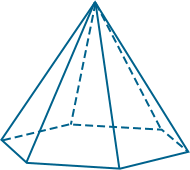Hexagonal Pyramid.

Let be the volume of the largest hexagonal pyramid that can be inscribed in a sphere of radius .
In the hexagonal pyramid with volume to the right, find the angle (in degrees) between two adjacent slant faces to two decimal places.
The answer is 129.52.
This section requires Javascript.
You are seeing this because something didn't load right. We suggest you, (a) try
refreshing the page, (b) enabling javascript if it is disabled on your browser and,
finally, (c)
loading the
non-javascript version of this page
. We're sorry about the hassle.
Let O P be the height H of the hexagonal pyramid.
Let E : ( 2 − x , 2 3 , 0 ) , A : ( 2 − x , 2 − 3 , 0 ) , F : ( − x , 0 , 0 ) , P : ( 0 , 0 , H ) .
F P = x i + 0 j + H k , E P = 2 x i − 2 3 x j + H k , A P = 2 x i + 2 3 x j + H k
u = F P × E P = 2 3 x H i − 2 x H j − 2 3 x 2 k and v = F P × A P = 2 − 3 x H i − 2 x H j + 2 3 x 2 k
u ⋅ v = 4 − x 2 ( 2 H 2 + 3 x 2 ) and ∣ u ∣ = ∣ v ∣ = 2 x 4 H 2 + 3 x 2 ⟹ cos ( θ ) = ∣ u ∣ ∣ v ∣ u ⋅ v = 4 H 2 + 3 x 2 − ( 2 H 2 + 3 x 2 ) , where θ is the angle between the two adjacent slant faces.
Let V s = 3 4 π R 3 be the volume of the sphere.
The Area A h e x a g o n = 2 3 3 x 2 ⟹ V p = 2 3 x 2 H
In the right triangle above: A C = H − R , B C = x , A B = R ⟹ x 2 = 2 H R − H 2 ⟹ V p ( H ) = 2 3 ( 2 H 2 R − H 3 ) ⟹ d H d V p = 2 3 H ( 4 R − 3 H ) = 0 H = 0 ⟹ H = 3 4 R ⟹ x 2 = 9 8
Using H 2 = 9 1 6 R 2 , x 2 = 9 8 R 2 and cos ( θ ) = 4 H 2 + 3 x 2 − ( 2 H 2 + 3 x 2 ) ⟹ cos ( θ ) = 1 1 − 7 ⟹ θ = 1 2 9 . 5 2 ∘